Salt. It’s on every restaurant table and in most every home. We reach for the shaker without regard for its provenance – where it comes from, how it’s processed, or the means by which it arrives on grocery store shelves. In the 21st century salt is an abundant, inexpensive commodity that we take for granted. Yet it wasn’t always so.
Though there is no written documentation to prove the use of salt in prehistoric times, it is commonly accepted that salt must have been an indispensable ingredient in eastern Europe as far back as 6,600 B.C.. As hunter-gatherer cultures began shifting to more complex economic systems based on farming and animal husbandry, salt would have been required to maintain the health of livestock, process milk, tan leather, preserve and season food. Salt was unevenly distributed across the region and by the Middle to Late Bronze Ages (16th to the 13th centuries B.C.), salt-rich communities were exporting to salt-poor regions in far southeastern Transylvania, west to the Hungarian Plain, and likely as far as the Balkan peninsula.
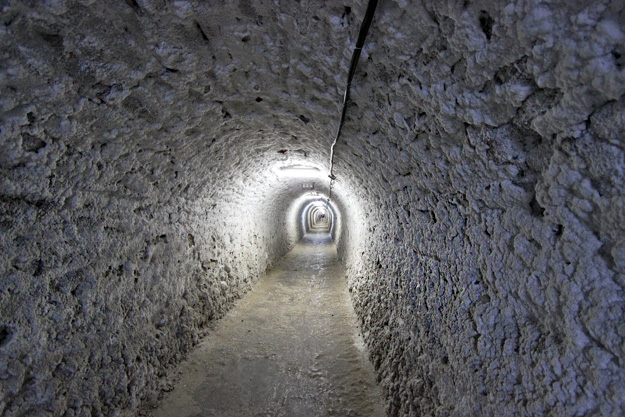
The first written records of salt production and trade in eastern Europe appeared during the Medieval Ages. A document issued by the Hungarian chancellery in 1075 mentions a salt custom house “in the citadel called Turda” and in a subsequent document dated 1271 “the salt mine in Turda” was offered to the Head of the Catholic Church of Transylavania. In the spring of 1552, a report made by royal inspectors called the salt mine of Turda the most important in Transylvania. Indeed, the salt deposits in this part of the Transilvanian plateau cover an area of about 17 square miles and average 820 feet in depth, with some deposits being nearly 4,000 feet thick!
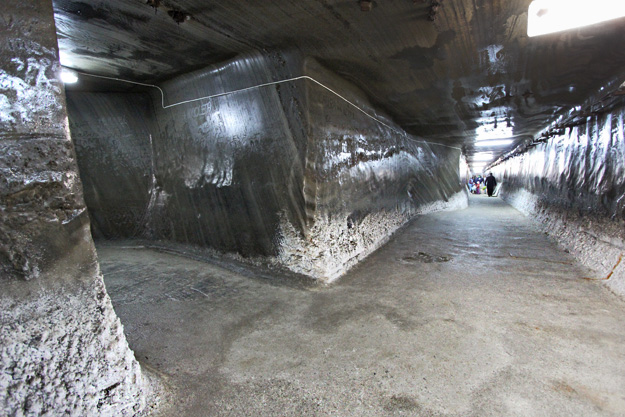
To my delight, I learned that the Salina Turda Salt Mine, which closed down in 1932, had been reopened as a tourist attraction in 1992. On my last day in Cluj-Napoca I hopped on a mini-bus for the 35-minute ride to Turda, where I caught one of the shuttle buses that run continuously between the town center and the mine. After a short briefing by an employee who showed me a large map and suggested the best route to take, I began a long climb down through a tunnel that might have been bored by a giant mole. As the temperature plummeted, the walls began to sweat, transforming them into black mirrors. Fascinated, I reached out to touch the slick surface and recoiled, repulsed by the clammy, oily feel of the weeping black salt.
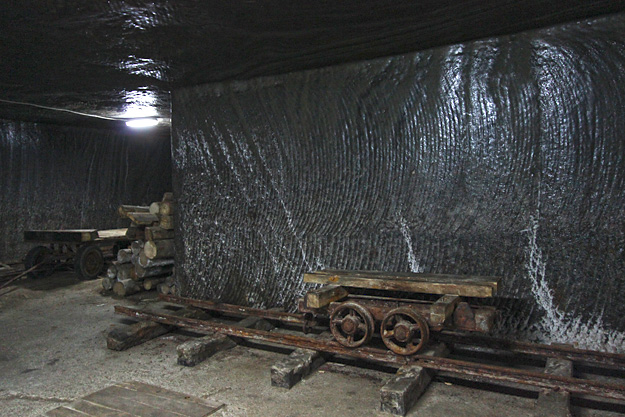
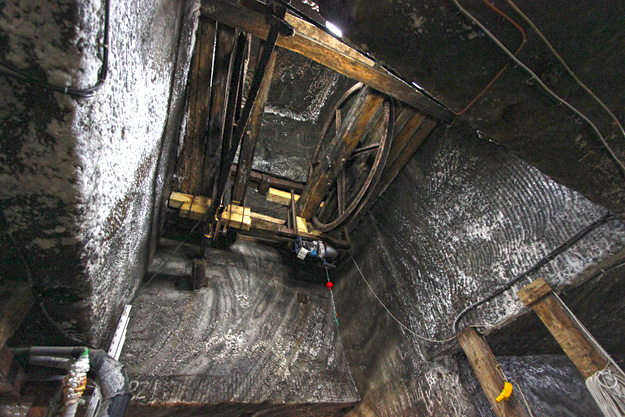
At the bottom of the stairs the tunnel widened into the Franz Josef Gallery, a horizontal passage that was completed in 1870 to facilitate the movement of salt to the surface. Being careful not to slip on the polished salt floor, I followed passageways that branched off to echo chambers and rooms displaying ancient extraction and transport machines, eventually arriving at the Rudolf Mine, the last area that was actively excavated at Turda. A wooden walkway, cut into a ledge at the top of the cavern, provided a bird’s eye view of the 138-foot deep rectangular excavation.

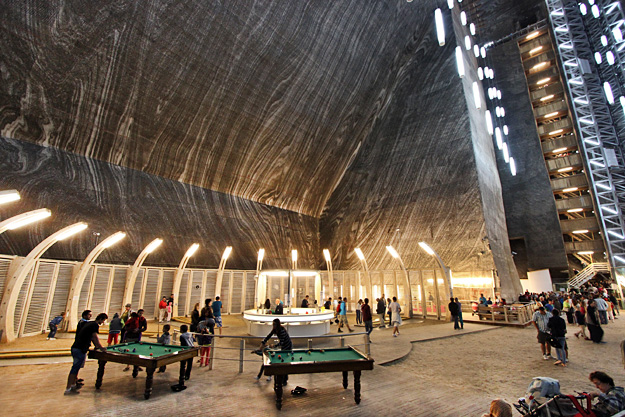
Rather than suffer long lines waiting for the only elevator, I opted for the 172 steps that led down to the floor of the mine, where families were enjoying an amusement park complete with mini-bowling, mini-golf, merry-go-round, children’s playground, billiard tables, and Ferris wheel. Off to one side I found a second observation platform overlooking the bell-shaped Terezia Mine, which plunges an additional 393 feet and features an underground lake with rowboats.
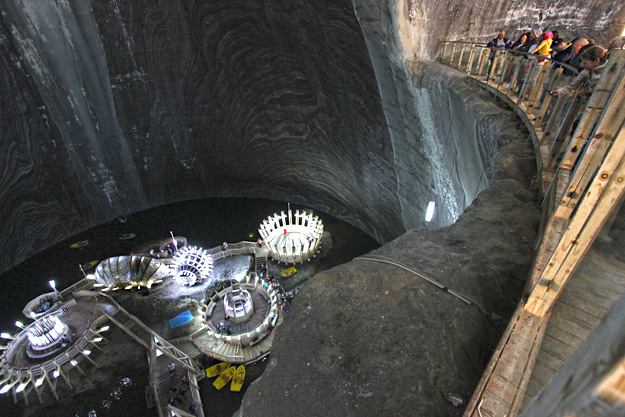
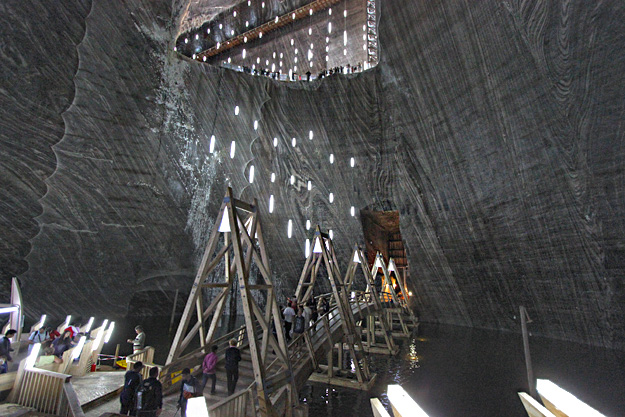
Though most visitors were there for the entertainment, I was fascinated by the geology of the mine. Salt stalactites hanging from the ceiling grow to nearly ten feet in length before breaking off from their weight. The sheer walls are zebra-striped in shades of black, grey, and amber, evidence that layers of evaporated salt were laid down over eons as inland seas alternately flooded and receded from eastern Europe. Plate tectonics folded and tilted the salt layers, creating a fascinating pattern of stripes and wavy lines that was exposed when the mines were excavated. These geologic forces occurred deep underground, thus the salt at Salina Turda is exceptionally pure, testing at more than 99% sodium chloride. Because of its purity, researchers theorize that in addition to being used by the local community and mined on an industrial scale for export and trade, salt from the Turda mine was also an exotic good with a highly symbolic value. Having the resources to own a product that was as valuable as gold implied power, vitality, connection with sacred places, and even immortality.

Salt has long been used in religious ceremonies. Until recent times, a small amount of salt was placed on the lips of a baby being baptized in the Catholic Church. In Leonardo da Vinci’s famous painting, The Last Supper, Judas Iscariot has spilled the salt, which is considered to symbolize bad luck and/or evil. From this comes the practice of throwing a bit of the white stuff over our left shoulder whenever salt is spilled, an action believed to ward off the devil. The bible is rife with symbolic references to salt: Lot’s wife was turned to a pillar of salt when she looked back at Sodom and Gomorrah and Jesus called his disciples salt of the earth. Buddhists believe that salt repels evil spirits and Jews still dip their bread in salt on the Sabbath when passing the bread around the table after the Kiddush. Salt was widely used to cast spells in the eastern European folklore tradition and is still considered a magical substance in the Wicca religion.
As Margaret Visser has said in her book, Much Depends On Dinner:
“Salt is the only rock directly consumed by man. It corrodes but preserves, desiccates but is wrested from the water. It has fascinated man for thousands of years not only as a substance he prized and was willing to labour to obtain, but also as a generator of poetic and of mythic meaning. The contradictions it embodies only intensify its power and its links with experience of the sacred.”

Given salt’s long history with the sacred, converting the Turda mines to an amusement park struck me as slightly profane. I shared my thoughts with another visitor as I was waiting in line to exit and learned that the mine also serves as a medical treatment facility. The constant air temperature, virtual lack of allergens, presence of aerosol salt particles, and predominance of positive ions in the air have been found to have a curative effect for patients with severe respiratory conditions, many of whom are children. The amusement park was installed to entertain kids who must spend long hours breathing the air at the bottom of the mine. As I climbed to the surface I breathed deeply, filling my lungs with positively ionized air, on the off-chance that the ancients who believed in the magical properties of salt knew something we don’t.
How to visit the Salina-Turda Salt Mine in Turda, Romania:
Turda can be reached from Cluj-Napoca by mini-vans that leave hourly from the corner of Piata Mihai Viteazu and Strada Ion Popescu Voitesti. The cost is 35 Lei (about $10 USD) and the trip takes approximately 35 minutes. The shuttle bus from Turda to the mine is approximately $2 USD each way. The mine is open seven days a week, from 9 a.m. to 5 p.m., with the last entry allowed at 4 p.m. Admission is approximately $6 USD per person for adults, $3 USD per person for children and students, and about $3.60 USD for retirees.
Check prices for accommodations in Cluj-Napoca at Booking.com, Hotels.com, or HotelsCombined.com. Read reviews about hotels and guest houses in Cluj-Napoca, Romania at TripAdvisor.
Disclosure: This article contains affiliate links to hotel booking sites. If you click on any of the links and make a booking, I may earn a small commission, which keeps this blog free to read.

Romania is a really spectacular place to visit. Now in January is snowing and the scenery looks like a fairy tale.
Such a beautiful place, i have recently been there and took some shots. http://travelbugtours.ro/turda-salt-mine-gallery/
Gorgeous photos Calin.
It’s not surprising that Turda Salt Mine has become a place for entertainment – sort of . It’s better to use it this way if salt is no longer extracted than to use it as a storage place for cheese, like it used to be for some time after WW II. And it’s also great that children learn more about salt mines and appreciate how important it is to value natural resources.
Hi Luminita: Agreed. It would be a shame to let it lie empty and idle.
Hi,
How much time do you reckon minimal to visit the mine?
Hi Michael: Well, it depends where you are coming from. If you mean how much time to actually see the mine once you get there, it could probably be done in 2-3 hours. But more if you’re taking a bus to get there.
I’ve spent the last ten days in Turda and Cluj, going to the mine each day, and have some updated info on logistics and a stronger dollar than three years ago.
Buses from Cluj leave about every 20 minutes — same place — run by two companies, and cost seven lei each way, which is currently a little less than two dollars. I didn’t see, and wasn’t told about a regularly running shuttle to the mine from the city center. Instead I had to take the city bus that goes to the mine — number 17. It’s not a popular route and runs only every hour and a half. Cost is 4.50 lei for the round trip — a little over a dollar — but no one ever checked to see if anyone had tickets.
Coming from Cluj, if you get off on the last stop before the city center, it is just a short, flat walk — about half a mile — to the new entrance, but then you will walk another half mile through a tunnel to get to the main part of the mine. You can walk to the main entrance from the city center — a little less than a mile — but it is a steep uphill climb.
Taxis are always around in Turda, and always run on the meter, so pretty cheap. They’re always on the meter in Cluj also, unlike Budapest, where if you hail one in the streets and ask to go back to your hotel, often they will try to go off-meter and charge you about three times what it would cost otherwise. I was told a story by a desk clerk of a poor couple from Indiana who paid $75 for a taxi ride they could have walked in 15 minutes, and would have paid a little over a dollar for on the meter. The Bucharest hotels will all call cabs for you that run on the meter — and it really is very cheap — but coming back you’re on your own, and may have to check with a few cabs before finding one not trying to rip you off. Tell them to go on the meter, or make an offer you can live with. Even the rip-off prices are usually better than the U.S.
I was interested in checking out the alleged health benefits of the salt mine — for respiratory ailments and skin conditions. Can’t say I noticed much difference with my minor respiratory ailments, tough these issues are noticeably quieted down while you’re in the mine. I was fighting a bug the whole time, so that may have countered any normal therapeutic effects. I do know of those who have had dramatic recovery from severe respiratory conditions by going down into the salt mines for several days.
Go on a weekday if you can. Otherwise you will either be negotiating a lot of stairs or waiting in line half an hour for the elevator.
Really a funky place. The lagoon at the bottom put me in mind of the River Styx.
Hi Gordon: Thanks so much for the updated information!
Hi!
I want to use your pictures of the salt mine for a music trailer of
a made up thriller that I’ve come up with.
Hope it is OK with you! 🙂
I visited the salt mines there last week and was in awe !!! I enjoyed every second I was in the mines. Did not do the boat ride or the ferris wheel as our time was limited. Think I will need to put this on our list of to see each time we go home
Hi Terry: Glad you were as fascinated as I was!
Very interesting post and great pictures. I know about the salt mine in Turda (I’m originally from Romania) but never crossed my mind to go visit it. We are always looking for fabulous places farther away from home. The grass is always greener on the other side of the fence.
Hi Anda: Funny how we rarely go to see the things that are closest to home. I’m guilty of the same back in Chicago. If you get the chance to see it, the salt mine is definitely worth a visit.
Andrei and I, we loved this salina when we were in our vacation in the Apuseni Mountains a couple of years ago. We, of course, didn’t miss the ferris – didn’t manage to go for a boat ride or stay more than one hour as we were with our dog and there were 37 degrees and more outside…
This looks awesome! What’s the entrance fee for the mine?
Hi Mighty Travels: You’ll find all the pertinent details about opening hours, locating, price, etc. at the bottom of my story.
This is incredible! We’ve not yet been to Romania yet, but this is going on the list of places we need to visit.
I think you have also been to the salt mine near Krakow, Poland. Which did you like more?
Hi Jennifer: I think you’ll be intrigued by Romania. I saw so little of it, compared to what it offers, so look forward to going back. Haven’t been to the Krakow mine, but if it’s the one I think it is, with all the intricate carvings out of salt, it is supposed to be magnificent.
Very cool pics. this looks like quite an experience.
It was absolutely fascinating, northierthanthou
Wow! I kind of imagining how much salt they could dig up on this huge tunnel. Thanks for sharing the history of this place.
You’re welcome, Adam. So glad you enjoyed it – I had exactly the same reaction you did about the amount of salt found just below the surface of the land.
Those walls are absolutely gorgeous.
Thanks M. Gellens. I loved seeing the stratification, so deep beneath the ground, that provides proof positive of tectonic forces beyond our imagining.
crazy!
Good word for it Hogga – crazy how little thought we give to salt when we lift the shaker, huh?
Awesome insights on Romania here. Glad i ran into your blog.
Thanks Hannah; so glad you found it interesting.
In these modern times, I still find it difficult to appreciate how important salt was in medieval and older times.
We do tend to take it for granted, Mark. And I, for one, could not live without it.
I’m amazed at how deep the mine is – it makes me dizzy looking at the photos
It was eerily deep Heather. And it was almost startling how cold it was down there!
I’m really in awe of this mine.
In Bendigo, two hours from Melbourne, Australia they did something similar with an old mine that was no longer in use. The converted part of it into a function room in order to raise income to repair the rest of the mine for visits by tourists. But it’s nowhere near the scale that this is on and it was an old gold mine that has since re-opened and not a salt mine like this one is.
I’ve really got to give credit to the locals for having the ingenuity to come up with and implement such a concept. It’s smart ideas like these that will enable small communities like the one I live in to continue to prosper and in some cases to continue existing into the future.
I was impressed as well, Matthew. Especially since in Eastern Europe, it’s still not easy to open a business. The fact that they pulled this off is practically a miracle, though I do believe they had substantial help from the European Union.
Beautiful pictures, it’s a whole different world down there.
Thank you Gabriel. The Turda salt mine is definitely “otherworldly.”
What an interesting place. I always seek out salt mines and salt lakes, so I would have gone here as you did. But, I’m amazed at the new uses for the mine. Now I will double my efforts to go.
Corinne: If you go, bring a jacket. It’s pretty chilly down there!
It’s really just the most ingenious way to renew the fortunes of a mining town whose mine has dried up. Just charge for entry and you’ve got a whole new source of income. And for mining towns, that’s pretty important.
It’s definitely a source of income for them Snarky, and one that is ongoing, since many of the shallower mines at the surface have been flooded and are now used as spa/bathing areas because he water contains a lot of beneficial minerals.
Grea syory about salt and the mine.
Thanks
Thanks Charles! I appreciate that you took the time to leave a comment.